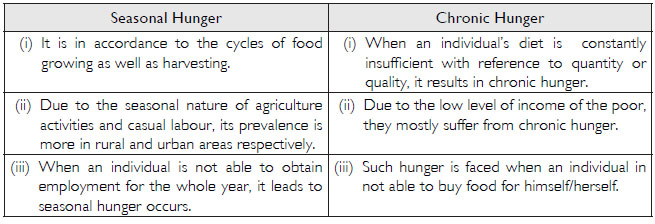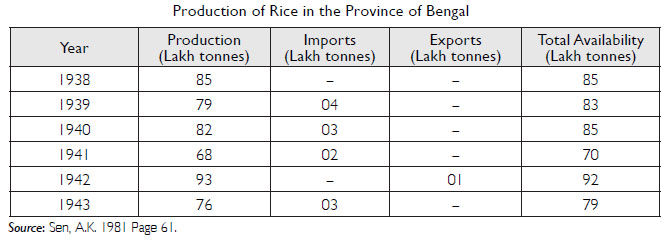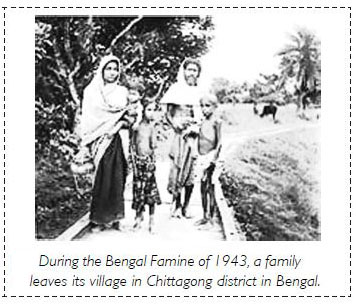Question 1:
How is food security ensured in India?
Answer:
In India, food security is ensured through its two components:
(i) Buffer Stock: In cases of scarcity of food, these foodgrains are distributed in the
affected
areas, among the underprivileged sections of the society at lower prices. This also resolves
the
problem of food scarcity during unfavourable weather conditions.
(ii) Public Distribution System: The food bought by the FCI is disseminated through
government
regulated ration shops among the poorer section of the society. This is called the Public
Distribution System (PDS).
Question 2:
Which are the people more prone to food insecurity?
Answer:
Following people more prone to food insecurity:
(i) The Scheduled Castes, Scheduled Tribes and some sections of the OBC’s who either have
low
land-base or poor land productivity face food insecurity.
(ii) The groups that have lost their ability to earn or produced due to natural disasters
and who
migrate from one place to another in search of livelihood are also among the most food
insecure people.
(iii) A large proportion of food insecure population constitutes of pregnant and nursing
mothers
and children under the age of 5 years.
Question 3:
Which states are more food insecure in India?
Answer:
States which are more food insecure in India are eastern and south-eastern parts of Uttar Pradesh, Bihar, Jharkhand, Odisha, West Bengal, Chhattisgarh, parts of Madhya Pradesh and Maharashtra.
Question 4:
Do you believe that green revolution has made India self-sufficient in foodgrains? How?
Answer:
Yes, Green Revolution has made India self-sufficient in foodgrains in the following ways:
(i) Increase in Production: Green Revolution has increased the production of various crops
manifold.
The production of foodgrains was just 7.23 million tonnes in 1964–65, which has increased to
218 million tonnes in 2009–10.
(ii) Control over Imports: After Independence, India was dependent on other countries for
its
foodgrain requirements. But now, our imports of foodgrains are negligible.
(iii) Overflowing Buffer Stocks: The minimum buffer norms for FCI are 24.3 million tonnes.
However, after the success of green revolution, the stock is much more than the minimum
norms.
Question 5:
A section of people in India are still without food. Explain.
Answer:
Food security is faced by different sections of the society who either have low land-base or poor land productivity. Food insecurity especially affects those groups that have lost their ability to earn or produced due to natural disasters and who migrate from one place to another in search of livelihood. Women in rural areas suffer the most due to malnutrition. A large proportion of food insecure population constitutes of pregnant and nursing mothers and children under the age of 5 years.
Question 6:
What happens to the supply of food when there is a disaster or a calamity?
Answer:
When a disaster or natural calamity such as earthquake, drought, flood, tsunami, etc., occurs or when due to unfavourable weather conditions, there is a widespread failure of crops, the food supply becomes scarce Due to this scarcity of food, the price of foodgrains rises due to which malpractices such as black marketing takes place. This results in the inability of food to reach the needy. At times, when such scarcity persists for a longer period of time, it may lead to starvation.
Question 7:
Differentiate between seasonal hunger and chronic hunger.
Answer:
Following are the points of difference between seasonal hunger and chronic hunger:

Question 8:
What has our government done to provide food security to the poor? Discuss any two schemes launched by the government.
Answer:
In order to provide food security to the poor, the government has designed the food security
system.
This system consists of two components-buffer stock and public distribution system. The
government
has also launched various programmes to alleviate poverty in the country some of these
programmes
are the Mid-Day Meal Scheme and food for work.
Question 9:
Why is a buffer stock created by the government?
Answer:
Buffer stock is created by the government due to the following reasons:
(i) Ensure Food Security: Buffer stocks are created by the government to ensure food
security. The
main aim of the buffer stock is to distribute the foodgrains in areas facing shortage of
food and
among the poor section of the society at low prices.
(ii) Overcome Calamity or Disaster: Another objective of the buffer stock is remove the
problem
of food scarcity at the time of a calamity or unfavourable weather conditions.
(iii) Provide Uninterrupted Supply of Foodgrains: For the purpose of providing uninterrupted
foodgrains supply throughout the year, it is necessary to maintain buffer stock.
(iv) Save Farmers from Fluctuations in the Market: Fluctuations in market prices create a
situation of
uncertainty among the farmers. Through buffer stocks, a pre-announced price for the crops
are
paid to the farmers.
Question 10:
Write notes on:
(i) Minimum Support Price (ii) Buffer Stock (iii) Issue Price (iv) Fair Price Shops
Answer:
(i) Minimum Support Price: Wheat and rice is bought from the farmers at pre-announced prices
by the FCI. Such price is called Minimum Support Price or MSP.
(ii) Buffer Stock: It is the stock of foodgrains obtained through the FCI, mainly wheat and
rice by
the government.
(iii) Issue Price: The price, lower than the market price, at which the foodgrains are
distributed in
the areas facing shortage and among the poor section of the society is known as Issue
Price.
(iv) Fair Price Shops: Fair price shops are the ration shops that stock foodgrains, sugar
and kerosene
oil and sell the same on prices lower than the market price.
Question 11:
What are the problems of the functioning of ration shops?
Answer:
Dealers at ration shops are often found resorting to malpractices, such as selling poor
quality grains.
They also open their shops at irregular timings and divert their grains to open market to
earn
better gains.
The unsold stock of ration shops often end up being piled up with the FCI.
Lastly, with the introduction of TPDS, families above the poverty line get very little
discount at
the ration shops. Thus, they resort to open markets.
Question 12:
Write a note on the role of cooperative in providing food and related items.
Answer:
The cooperatives are playing a significant role in ensuring food security in India.
Examples:
(i) Cooperatives run almost 94 per cent of all fair price shops in Tamil Nadu.
(ii) In Delhi, Mother Dairy is taking steps for providing milk as well as vegetables to the
consumers
at rates set by the Government of Delhi.
(iii) In Gujarat, Amul has started the White Revolution in India by bringing forward milk
and milk
products.
Question 13:

Some people say that the Bengal famine happened because there was a shortage of rice. Study the table and find out whether you agree with the statement?
Answer:
Bengal famine occurred in 1943. During that year, the total availability of rice was 79 lakh tonnes, which was sufficient to meet the needs of starving population.
Question 14:

Which year shows a drastic decline in food availability?
Answer:
According to the table, the food availability declined drastically from 85 lakh tonnes in 1940 to 70 lakh tonnes in 1941.
Question 15:
Why is agriculture a seasonal activity?
Answer:
In agriculture, sowing and harvesting seasons are the busiest period. However, there is no significant work during the rest of the year.
Question 16:
Why is Ramu unemployed for about four months in a year?
Answer:
Ramu works as a casual labourer in agriculture. Since agriculture is a seasonal activity, he remains busy during sowing, transplanting and harvesting but is unemployed for about four months in a year.
Question 17:
What does Ramu do when he is unemployed?
Answer:
Ramu looks for work in other activities when he is unemployed such as employment in brick-laying or construction activities in the village.
Question 18:
Who are supplementing income in Ramu’s family?
Answer:
Ramu’s wife Sunhari and his son are supplementing income in his family.
Question 19:
Why does Ramu face difficulty when he is unable to have work?
Answer:
When Ramu is not employed in an activity, he and his family face difficulties and sometimes his small kids have to sleep without food.
Question 20:
When is Ramu food insecure?
Answer:
Ramu is food insecure during 4 months when he remains unemployed because of the seasonal nature of agriculture work.
Question 21:
Does Ahmad have regular income from rickshaw-pulling?
Answer:
No, Ahmad does not have a regular income from rickshaw-pulling. His employment is insecure and earnings fluctuate every day.
Question 22:
How does the yellow card help Ahmad run his family even with small earning from rickshawpulling?
Answer:
With the help of a yellow card, Ahmad gets sufficient quantity of wheat, rice, sugar and kerosene oil at half the market price. This helps him to run his family even with small earnings from rickshaw-pulling.
Question 23:
Study the graph and answer the following questions:
In which year did our country cross the 200 million tonnes per year mark in foodgrain production?
Answer:
Our country crossed the 200 million tonnes per year mark in foodgrains production in the year 2005-06.
Question 24:
Study the graph and answer the following questions:
In which decade did India experience the highest decadal increase in foodgrain production?
Answer:
India experienced the highest decadal increase in foodgrain production during 1990s.
Question 25:
Study the graph and answer the following questions:
Is production increase consistent in India since 2000–01?
Answer:
No, the production increase is not consistent in India since 2000–01.
Question 26:

What do you see in the given picture?
Answer:
Picture 1 shows the victims of starvation arriving at a relief centre in 1945.
Question 27:

Which age group is seen in the pictur
Answer:
People belonging to the old age group can be seen in Picture 1.
Question 28:

Can you say that the family shown in the given picture is a poor family? Why?
Answer:
The family shown in the Picture 2 is a poor family, because this family is leaving its village due to poverty.
Question 29:

Can you imagine the source of livelihood of the people, (shown in two pictures) before the occurrence of famine? (In the context of a village)
Answer:
The source of livelihood of the people before the occurrence of famine could be agriculture and its allied activities.
Question 30:

Find out what type of help is given to the victims of natural calamity at a relief camp.
Answer:
The victims of a natural calamity were given food, clothes, medicines, money, etc. at relief camp.
Question 31:
Visit some farms in a nearby village and collect the details of food crops cultivated by the farmers.
Answer:
I visited some farms in a nearby village and came to know that the following food crops are
cultivated by the farmers:
(i) Wheat (ii) Rice (iii) Maize
Question 32:
Visit your area’s ration shop and get the following details:
When does the ration shop open?
Answer:
The ration shop opens at 9.30 a.m.
Question 33:
Visit your area’s ration shop and get the following details:
What are the items sold at the ration shop?
Answer:
Wheat, rice, sugar, kerosene, etc. are sold at the ration shop.
Question 34:
Visit your area’s ration shop and get the following details:
Compare the prices of rice and sugar from the ration shop with the prices at any other
grocery shop. (for families below poverty line)
Answer:
Wheat and rice are sold at ₹12 and ₹18 per kg respectively at other grocery shops, whereas people below the poverty line get them at ₹2.50 and ₹3.50 per kg respectively.
Question 35:
Do you have a ration card?
Answer:
Yes, I have a ration card. (Answer may vary)
Question 36:
What has your family recently bought with this card from the ration shop?
Answer:
Our family has recently bought sugar with this card from the ration shop. (Answer may vary)
Question 37:
Are there any problems that they face?
Answer:
Many a times the quality of the grains sold does not meet government-set standards. (Answer may vary)
Question 38:
Why are ration shops necessary?
Answer:
Ration shops are necessary for the upliftment of the poorer section of the society.

